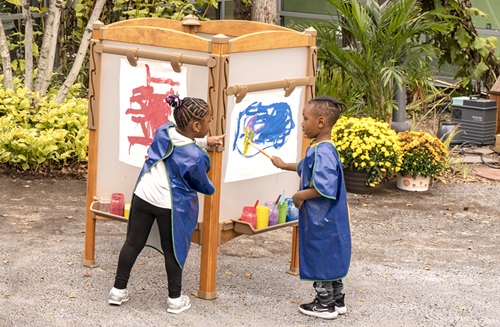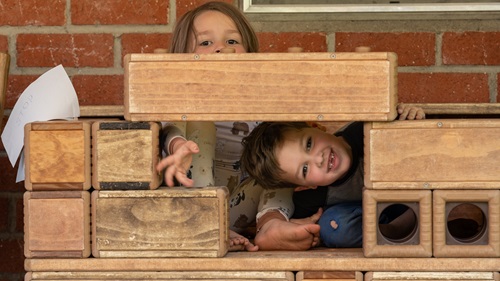Designing Your Outdoor Classroom
Four Types of Teaching Gardens
| February 2025Do you believe in the value of outdoor play but feel unsure about how to implement an effective strategy that maximizes learning?
Designing an outdoor space can seem overwhelming, especially if your expertise lies in parenting or education rather than landscape architecture and design. One way to help conceptualize the possibilities for your outdoor space is by looking through the lens of teaching gardens. This approach also underscores the importance of intentionality in outdoor design, crucial for your children's development.
While researching outdoor classrooms, I discovered four distinct types of teaching gardens, or children’s gardens. Alice Waters inspired me with the concept of edible gardens, while the National Wildlife Federation opened my eyes to wildlife gardening. My parents taught me the art of planting purely for beauty and artistic expression. Additionally, observing children’s joy as they engaged in mud kitchens, water walls, and maker space gardens highlighted the playful learning aspect.
It was through this exploration that I realized every teaching garden has specific elements and features that support child development. When combined, these four types of teaching gardens create the ultimate outdoor classroom for playful learning.
The four types of teaching gardens can serve as a foundational map for designing any outdoor learning space. Each type of garden supports unique learning experiences, offering distinct social, emotional, sensory, cognitive, and physical benefits. Parents and educators can mix and match to fit the needs of their space and program, creating a one-of-a-kind outdoor classroom that inspires children and helps meet learning goals.
Overview of Garden Types
Gardens as Outdoor Learning Stations: These gardens act as natural extensions of the classroom, offering hands-on educational opportunities through themed areas like Mud Kitchens, Rock Gardens, and Sensory Gardens. By incorporating playful themes, they invite exploration and inquiry, fostering cognitive development and creativity. These dynamic spaces support sensory development by engaging all senses and enhance physical skills through creative play activities. Children learn through play, connecting curriculum concepts with tangible, experiential learning in an outdoor setting, nurturing curiosity and promoting a lifelong love of discovery.;
Gardens for Art and Beauty: Artistic gardens, rich with sculptures, vibrant plantings, and flowers, serve as community spaces that connect children of all ages with art and beauty. These gardens are designed to stimulate creative expression by incorporating activities such as dance, poetry, storytelling, and painting. Social-emotional development is strengthened as children share creative experiences, build community connections, and develop appreciation for aesthetics and the natural world. These spaces encourage collaborative art projects and imaginative play, fostering social skills and empathy as children learn to appreciate diverse forms of expression.;
Gardens that Attract Wildlife: Attracting wildlife through gardens that provide food, water, and shelter allows children to witness firsthand the wonders of ecology and environmental stewardship. These gardens promote empathy and responsibility as children learn to care for and protect wildlife habitats. Engaging with wildlife enhances sensory experiences and supports emotional development, as children find joy and fascination in observing creatures such as butterflies and birds. It instills a sense of guardianship over the environment and a deeper understanding of ecosystems.;
Gardens that Feed: Edible and vegetable gardens teach children about nutrition and the origin of food, offering rich sensory experiences as they see, harvest, and taste what they've grown. These gardens reinforce the importance of healthy eating and the lifecycle of plants, promoting physical well-being and cognitive learning. Working in edible gardens encourages teamwork, patience, and responsibility as children collaborate on growing and maintaining their plots. It also cultivates a sense of achievement and pride, boosting confidence as children savor the fruits of their labor.;
Educators can leverage the benefits of each garden type to create environments that meet a diversity of developmental needs. Intentional design allows a broad array of learning goals to come together into a comprehensive outdoor space.
Setting Up Your Gardens
Now, it's time to transform your vision into reality by creating a vibrant outdoor classroom. This will become a lively space where children engage in playful learning and exploration. With our blueprint in hand, and an understanding of why these four gardens are important for children’s sensory, physical, and social-emotional development, you will be ready to embark on this exciting journey.
Gardens as Outdoor Learning Stations
Our journey begins with the Gardens as Outdoor Learning Stations, where numerous possibilities await. To set up these stations, simply choose the type of learning experience you want to create, identify the right location, and select the elements to enrich the environment. A favorite among children of all ages is the Mud Kitchen, celebrated for its rich sensory experiences. Whether simple or elaborate, a Mud Kitchen can easily be started with basic items like old pots and pans, a tabletop, dirt in a container, water access, and nature’s loose parts. From there, let the children’s imaginations run wild, and they’ll guide you on what’s needed next.
Gardens for Art and Beauty
The adventure continues in the Gardens for Art and Beauty, blending vibrant flower beds of diverse colors and textures with dedicated outdoor art creation spaces. In my Secret Gardens Outdoor Classroom, an innovative outdoor easel emerged from a shower curtain strung between two trees. Picnic tables complement this setup, while an outdoor shed for art supplies creates the perfect environment for creativity to flourish. Planting bulbs with children here not only teaches them to nurture flowers but also inspires them to craft kindness bouquets. Add painted stone paths, child- inspired statues, and a Music Wall with a performance stage, and watch the playful learning erupt.
Gardens that Attract Wildlife
Welcoming birds, insects, and butterflies into your Gardens that Attracts Wildlife is essential for any outdoor classroom. You don't have to be an expert environmentalist to share the joys of birdsong and the wonder of butterflies with children. Soon enough, you'll find yourself learning about native plants and how to best invite these creatures into your outdoor space. Create a log-hotel to uncover a hidden habitat, plant a butterfly garden to witness the marvel of pollination, and set up a bird bath to attract and nourish visiting birds. Observe as children explore and navigate their surroundings, learning to coexist with wildlife and share their space harmoniously.
Gardens That Feed
Our journey concludes with Gardens that Feed, where children discover the origins of their food. The opportunities here are vast. Whether planting seeds or exploring specific gardening techniques for growing leaves, roots, and fruits, the choice is yours. Understanding what to plant, when to plant it, and selecting the best crops for children are essential elements for success. Encourage children to grow their own salad, host a harvest celebration, and create herb-based projects. Cultivate curiosity about the flowers on a tomato vine and observe their transformation in the sun. Invite children to keep nature journals, where they can write imaginative stories, measure growth, and draw detailed plant observations, fostering both scientific inquiry and creative expression. Listen and “tune -in” to your children as learners, as it will guide you in your role as an educator.
Spaces That Transform
The transformational journey within the four types of teaching gardens is ongoing. Each changing season offers a fresh canvas, providing endless opportunities for learning that inspire inquiry, wonder, and curiosity. By intentionally setting up an outdoor space using these gardens, you open the door to sensory, physical, cognitive, and social-emotional learning experiences. The benefits of such intentionality in design are transformative, playing a crucial role in child development. Our mission as educators, is to craft outdoor spaces that foster deeper engagement with the natural world through exploration, playful learning, and connection. The four types of teaching gardens provide a roadmap to begin this journey, helping us create unique and inspiring outdoor classroom stories.












